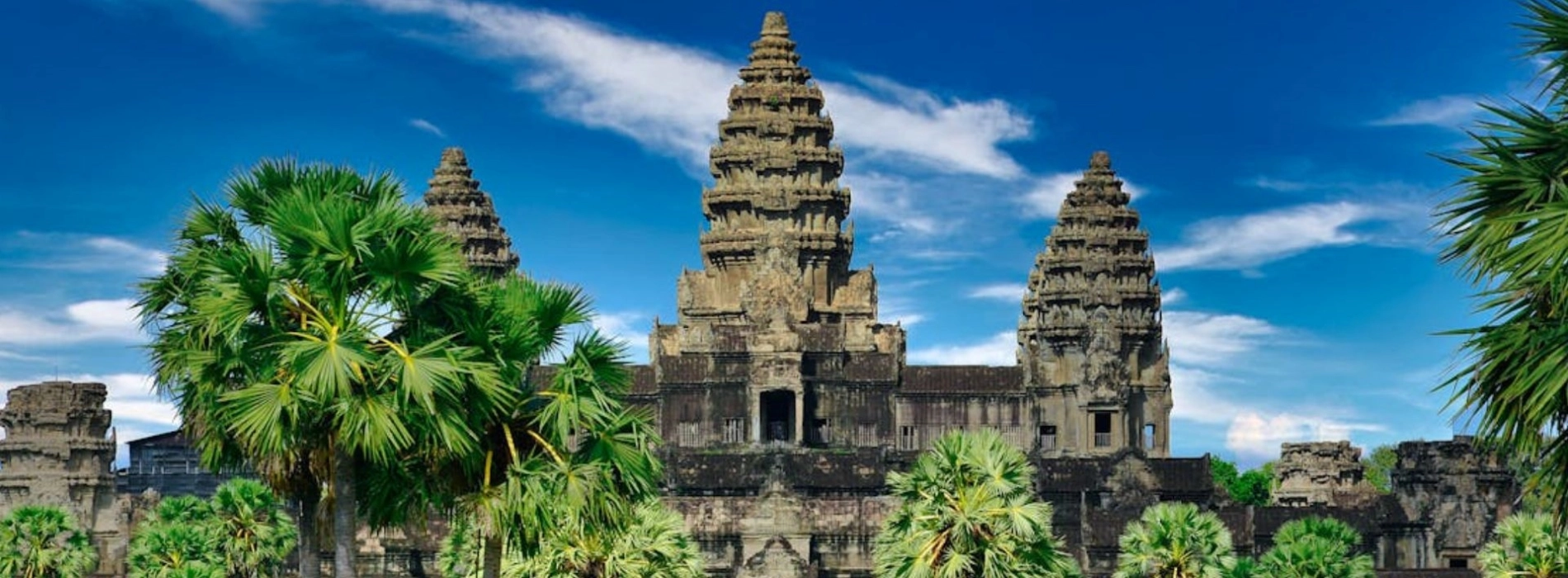
Traditional Cambodian costumes, deeply intertwined with the nation's cultural heritage, boast a profound history. The Sampot, serving as Cambodia's emblematic attire, symbolizes both national pride and the intrinsic cultural identity of its people.
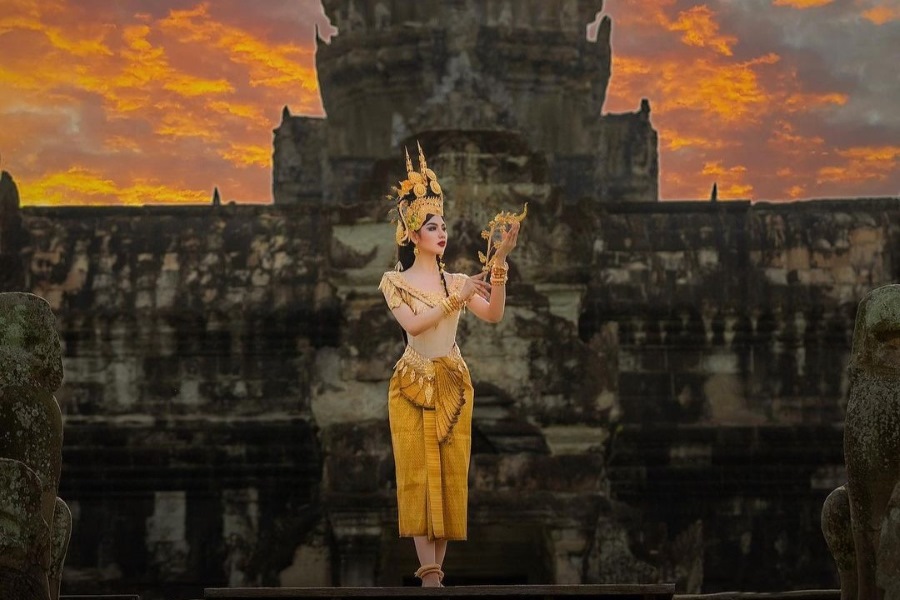
Cambodian traditional costumes are attached to the nation's cultural (Cre: sotimajohnn_official)
Some information suggests that Sampot originated from the ancient Khmer people based on images and sculptures at Angkor ruins. According to archaeologists, the Khmer people lived in Southeast Asia as early as the 2nd century BC and were the first known civilization in Cambodia. They established a magnificent empire, spanning from the 9th to the 15th century, with Angkor serving as its capital region.
Furthermore, Cambodia's traditional attire has its roots in the Funan dynasty. Funan was an ancient kingdom that existed from the 1st to the 7th century. Part of Funan's territory was formed by the earlier Mon-Khmer people. During the Funan era, the king mandated that people wear a specific type of clothing as requested by Chinese envoys. Adhering to this decree, skilled tailors diligently crafted the most suitable garments from soft silk. It was during this time that the Sampot emerged and quickly became popular among the people.

Sampot becomes popular and widespread (Cre: ericking.space)
Currently, the Khmer ethnic group makes up more than 90% of Cambodia's population. Therefore, when you search for traditional Cambodian costumes, they will also be closely associated with the name "Khmer traditional costumes."
The sarong, a traditional attire in Cambodia mainly worn by the lower class, is designed for ease of movement. Its simplicity and convenience make it a popular choice for daily activities. Besides, when traveling in Cambodia today, you'll find sarongs readily available in clothing stores, as they offer both convenience and comfort.

The sarong brings comfort and convenience (Cre: Koun Tonsaysa)
Sampot is a traditional Cambodian costume created, developed and preserved by the Khmer people. Sampot is often made from soft and breathable fabrics such as cotton, silk, or rayon. This garment can be embroidered or printed with traditional Cambodian patterns, depending on the style and purpose. For special occasions, sampot can be crafted from luxurious fabrics and adorned with intricate embroidery or lace details.
.jpg)
Sampot - Traditional Cambodian costumes are usually used for many different events (Cre: paradise_wedding_planner)
Sampot is a large rectangular piece of cloth, approximately 5 to 6 feet in length, wrapped around the lower part of the body and tied at the waist. It can be wrapped in various styles without the need for sewing. Sampot is typically dyed in five colors: red, yellow, green, blue, and black.
There are 3 main types of sampot:
Sampot Chang Kben is worn like a skirt, longer than other types of sampot, with a length of 2.7 meters and a width of 1 meter. It is wrapped around the waist, covering the lower body, with a small knot tied in front of the abdomen and secured with a sparkling belt.
In the past, Sampot Chang Kben was typically worn by middle and upper-class women, as they were often woven from high-quality materials and embellished with intricate patterns. However, with the passage of time, today, all Cambodian women have the opportunity to wear Sampot Chang Kben.

The Sampot Chang Kben - one of the traditional Cambodian Sampot costumes (Cre: paradise_wedding_planner)
Sampot Phamuong is a highly popular woven fabric in Cambodia. It features 52 different colors woven diagonally across its surface. The luxurious material of Sampot Phamuong is crafted from 22 different types of threads, combined with countless motifs, floral patterns, and geometric designs. Among them, the most famous is the golden silk - the primary material of a Phamuong and the most renowned fabric in the Kingdom of Temples.
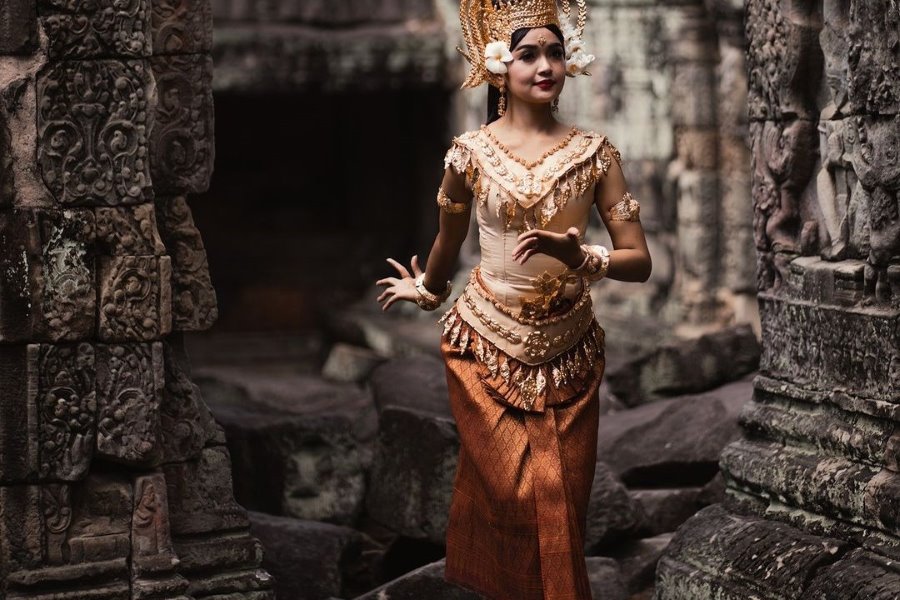
Apsara dance in traditional Cambodian costumes (Cre: roma_lim_)
Influenced by the Indian patola textile art, Sampot Hol has evolved over centuries to become a distinctive form of art in Cambodia. Sampot Hol is also a unique woven fabric of Cambodia.
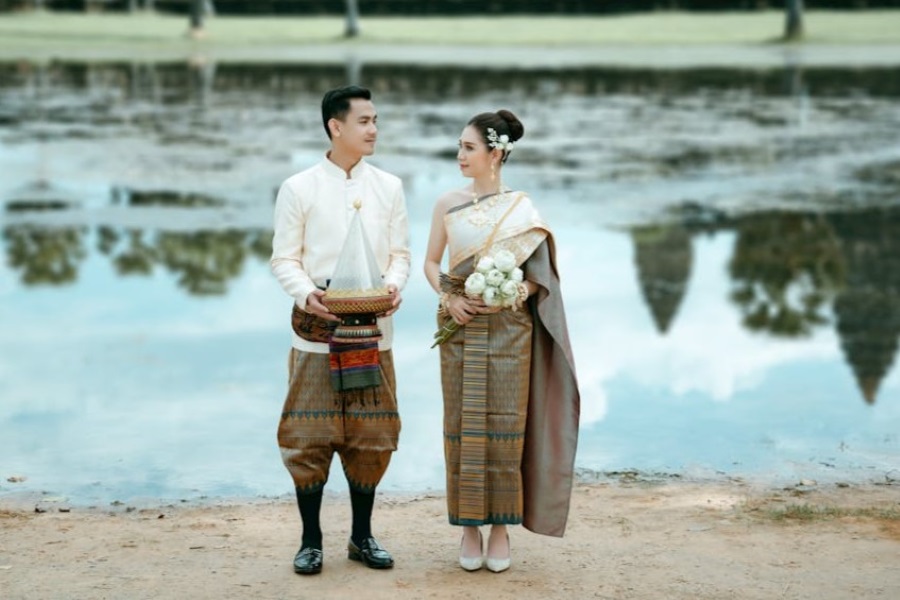
The couple took photos in sampot hol (Cre: internet)
There are two main weaving techniques: Chang Kiet and Twill Weave. Chang Kiet involves wrapping horizontal threads around vertical threads to create geometric patterns. Twill weave, on the other hand, produces diagonal lines on the fabric using a specific weaving method. There are over 200 unique geometric patterns along with motifs of animals and flowers.
In tradition, a combination of three to five colors is used, including yellow, red, brown, blue, and green. There are four main variations: sampot hol, sampot hol por, sampot kben, and sampot holong. Sampot hol is often reserved for special occasions or as heirloom pieces passed down through generations.
You may like: Khmer New Year: All about Cambodia’s Largest Festival
The Khmer Krama scarf is a versatile traditional Cambodian clothing, serving multiple purposes such as scarves , and face coverings. It can also be used for decorative purposes, such as tying it around the waist like a belt. Additionally, many women wear it on their heads, particularly when carrying items.

The Khmer Krama scarf is a versatile traditional Cambodian costumes (Cre: heritage_line)
Sampot is commonly worn by both men and women during festivals, ceremonies, and daily activities. Based on personal preferences, both men and women have suitable clothing combinations for different occasions.
For women
For men
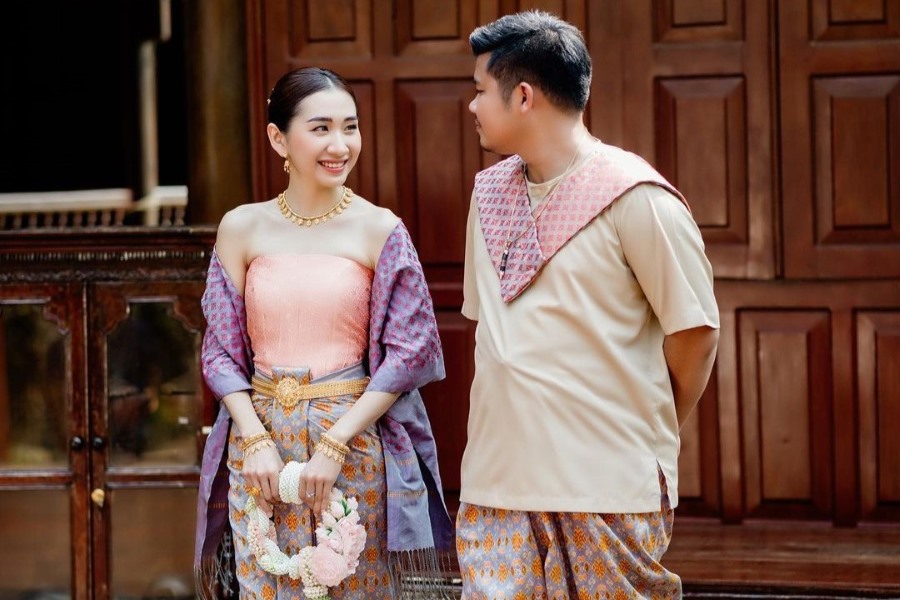
Accessories highlight traditional Cambodian outfits (Cre:internet)
Traditional Cambodian costumes can be worn on various occasions, including festivals, special ceremonies, and even in daily life. Therefore, it's important to choose suitable outfits that make the wearer feel comfortable and at ease.
As the renowned Kingdom of Temples, Cambodia is famous for its distinctive cultural heritage characterized by numerous grand temple complexes. To preserve the cultural values of the nation, traditional Cambodian costumes, with their unique designs, are closely intertwined with the culture and people, serving as a source of pride for the Cambodian populace.
With the information provided, we hope that Asia King Travel has left you with a profound impression of traditional Cambodian costumes. If you need further information, please don't hesitate to contact us. We are ready to accompany you and provide unique experiences.
You may like: Art and Culture in Cambodia: A Guide for the Creative Explorer